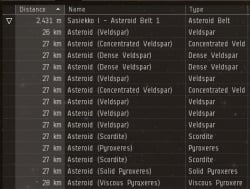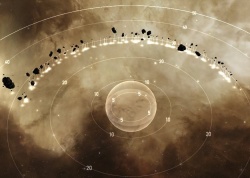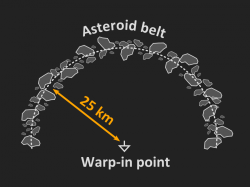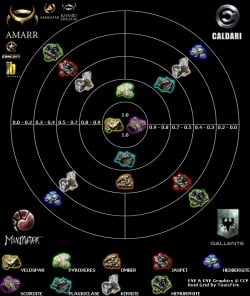Asteroids and ore
Reason: <Resource Distribution update in December 20, 2019, removed Veldspar and Spodumain from Null Sec Asteroid belts. Tables below require corresponding adjustment, unclear from change if other ores “fill” the slots emptied by these removals.>
- Main article: Mining
Asteroids are large irregular chunks of rock that can be found in many places throughout New Eden. When mined, asteroids yield ore which, when refined, produces minerals of various types that serve as the basic building blocks of almost every craftable item.
Where to find asteroids
Asteroid belts
Virtually every star system in EVE (with the notable exception of Jita) has at least one asteroid belt. Most star systems have several -- up to more than a dozen in some cases. These belts are listed on the overview and the right-click menu, and always have the same geometry: a rough semicircle of asteroids, approximately 50 km in diameter. A ship warping to an asteroid belt's beacon (through the right-click menu or the overview) will warp to the center of the semicircle. Note that mining lasers have an (unboosted) range of only 10-15 km, so in order to mine asteroids a ship has to fly closer to the belt after warping in. If you want to save on travel time, you can warp to mining bookmarks instead.
A given belt will have a mixture of asteroids containing different ores. The mixture and size of the asteroids (i.e. how much ore each asteroid contains) is determined by the system's location in the EVE universe and its security status (see asteroid distribution below). Each asteroid belt contains a finite number of asteroids (which disappear once fully mined), but the asteroids respawn after downtime if there are no asteroids left. The website Dotlan has maps showing the number of belts per system.
Deadspace pockets
Mineable asteroids can also spawn in deadspace pockets, such as the ones created for missions. Unlike asteroid belts, these are not organized into a set shape. Some are composed of dense clumps of asteroids, while others are scattered fields. For a list of which missions' deadspace pockets contain asteroids, see Mission Mining or EVE-survival.
Cosmic anomalies
Lastly, one of the two kinds of cosmic anomaly contains asteroids (the others contains hostile rats). The asteroids in cosmic anomalies tend to be a little larger and contain rarer ore than the normal asteroid belts in a star system. However, unlike asteroid belts, once all the asteroids in the anomaly have been mined, the anomaly disappears after broadcasting a short message in Local. As with all cosmic anomalies, new anomalies spawn semi-randomly.
Note that in many locations you will find decorative asteroids, which cannot be mined or otherwise interacted with. These will have colorful names such as "Snake-shaped Asteroid".
There are different types of asteroid cosmic anomalies, named by what kinds of ores are contained within. Each type comes in three variants (small, average, and large) - the "larger" the anomaly, the more asteroids (and hence the more ore) it contains. A "Small Kernite and Omber Deposit" therefore contains a small number of Kernite and Omber asteroids, while a "Large Bistot Deposit" contains a large number of Bistot asteroids. Ore anomalies will contain all three variants of the ores they contain.
High security space
- See also: High-sec
- Omber (small • average • large)
- Kernite and Omber (small • average • large)
- Jaspet, Kernite, and Omber (small • average • large)
- Hemorphite, Jaspet, and Kernite (small • average • large)
- Hedbergite, Hemorphite, and Jaspet (small • average • large)
Low security space
- See also: Low-sec
- Gneiss (small • average • large)
- Dark Ochre and Gneiss (small • average • large)
- Crokite, Dark Ochre and Gneiss (small • average • large)
- Spodumain, Crokite and Dark Ochre (small • average • large)
Null security space
- See also: Null-sec
- Bistot (small • average • large)
- Arkonor and Bistot (small • average • large)
- Mercoxit, Arkonor and Bistot (small • average • large)
Ore Prospecting Arrays
In player-owned sovereign nullsec, it is possible to deploy Ore Prospecting Arrays, a deployable sovereignty structure which, when deployed in a system, periodically generates asteroid clusters of various sizes at set intervals.
All sizes of asteroid clusters are capable of spawning regardless of system security status, and all clusters of a given size contain the same volume of ore, but asteroid clusters in lower security levels will spawn the more valuable ore variants with greater frequency. With the exception of Small Asteroid Clusters (which lack Mercoxit), all clusters contain varying amounts of all nullsec ore types: Arkonor, Bistot, Crokite, Dark Ochre, Gneiss, Spodumain, and Mercoxit.
- Small Asteroid Cluster • Medium Asteroid Cluster • Large Asteroid Cluster • Enormous Asteroid Cluster • Colossal Asteroid Cluster
Asteroid distribution

- For the distribution of ice asteroids, see Ice distribution.
The EVE universe can be divided into four quarters:
- The Amarr quarter (includes systems held by the Amarr, Ammatar, Khanid, Blood Raiders, and Sansha's Nation)
- The Caldari quarter (includes systems held by the Caldari and Guristas)
- The Gallente quarter (includes systems held by the Gallente and Serpentis)
- The Minmatar quarter (includes systems held by the Minmatar and Angel Cartel)
Each of these four quarters has its own set of asteroid types. Additionally, the lower the security rating of a system, the rarer the asteroid types that can be found there. Finally, each system can also include all the asteroid types of same-quarter higher-security systems. For example, a Gallente system with a security rating of 0.7 will have asteroid belts with not only Omber asteroids, but also Veldspar, Scordite, and Plagioclase asteroids.
Ores in null security space
Null security space is not as clearly defined as high security due to being player owned. Instead it is easiest to classify it by Security Class, which is most easily viewed via sites like Dotlan by using the Security Class filter on a map.
The following table shows the security class letter used for null security regions:
| Class Letter | Region |
|---|---|
| F | Detorid, Cache, Insmother, Impass, Feythabolis, Tenerifis, Omist |
| G | Stain, Esoteria, Querious, Paragon Soul, Delve, Period Basis |
| H | Vale of the Silent, Tribute, Venal, Geminate, Deklein, Tenal, Branch |
| I | Wicked Creek, Scalding Pass, Great Wildlands, Curse, Catch, Immensea, Providence |
| J | Pure Blind, Syndicate, Fade, Cloud Ring, Outer Ring, Fountain |
| K | Cobalt Edge, Perrigen Falls, Malpais, Oasa, Kalevala Expanse, Outer Passage, Etherium Reach, The Spire |
Using these, the type of ores available can be determined using the following table:
- Note that, going down each column, all ores present in the class above also spawn. For instance, "J" systems spawn Veldspar, Scordite, Pyroxeres, Plagioclase, and Jaspet. "J1" systems have all of those, plus Dark Ochre. "J2" systems have everything in "J1" systems, plus Crokite, and so on.
In general, the rarer the ore, the higher its volume per unit (e.g. one unit of Veldspar has a volume of 0.1 m3, whereas one unit of Arkonor has a volume of 16 m3). Since mining lasers mine a given volume of ore per minute, it takes longer to mine the rarer ore types. Additionally, each ore reprocesses into a different set of minerals. For details, see Reprocessing.
Note that mining Mercoxit requires the Deep Core Mining skill as well as special mining modules (Deep Core Miners or Deep Core Strip Miners). All other ore types can be mined with all types of ore mining lasers or strip miners.
| A long, long time ago... |
|---|
|
The Resource Distribution update on December 17, 2019 removed Veldspar and Spodumain from Null Sec Asteroid belts, and reduced the value of the largest Ore Prospecting Anomalies. It is as of yet unclear if the removed ore types were replaced with others at different security levels and classes. See this dev post for the official announcement, which deliberately came 3 days after the change. |
Ore variants
Each asteroid type has three further subtypes that yield more (+5% / +10% / +15%) minerals when reprocessed. Otherwise they are identical in every way to their base ore, and are found in the same regions, but in lower quantities, except for the +15% variant which is only found in moons. For instance, if an asteroid belt has Omber asteroids, it will also have some Silvery Omber asteroids and a few Golden Omber asteroids. If you get the chance, you should always mine the higher-yield variants before mining the base ore.
Ore Chart
| Ore | Vol- ume |
Batch size[oc 1] |
Mineral from 100%-yield reprocessing | Max security and quarter of EVE where ore can be found [oc 2] | |||||||
|---|---|---|---|---|---|---|---|---|---|---|---|
| Tri | Pye | Mex | Iso | Noc | Zyd | Meg | Mor | ||||
| Veldspar | 0.1 | 100 | 400 | 0 | 0 | 0 | 0 | 0 | 0 | 0 | 1.0 (All Space) |
| Concentrated Veldspar (+5%) | 0.1 | 100 | 420 | 0 | 0 | 0 | 0 | 0 | 0 | 0 | 1.0 (All Space) |
| Dense Veldspar (+10%) | 0.1 | 100 | 440 | 0 | 0 | 0 | 0 | 0 | 0 | 0 | 1.0 (All Space) |
| Scordite | 0.15 | 100 | 346 | 173 | 0 | 0 | 0 | 0 | 0 | 0 | 1.0 (All Space) |
| Condensed Scordite (+5%) | 0.15 | 100 | 364 | 182 | 0 | 0 | 0 | 0 | 0 | 0 | 1.0 (All Space) |
| Massive Scordite (+10%) | 0.15 | 100 | 381 | 190 | 0 | 0 | 0 | 0 | 0 | 0 | 1.0 (All Space) |
| Pyroxeres | 0.3 | 100 | 351 | 25 | 50 | 0 | 5 | 0 | 0 | 0 | 0.9 (Amarr, Caldari) |
| Solid Pyroxeres (+5%) | 0.3 | 100 | 369 | 26 | 53 | 0 | 5 | 0 | 0 | 0 | 0.9 (Amarr, Caldari) |
| Viscous Pyroxeres (+10%) | 0.3 | 100 | 387 | 27 | 55 | 0 | 5 | 0 | 0 | 0 | 0.9 (Amarr, Caldari) |
| Plagioclase | 0.35 | 100 | 107 | 213 | 107 | 0 | 0 | 0 | 0 | 0 | 0.9 (Gallente, Minmatar), 0.7 (Caldari) |
| Azure Plagioclase (+5%) | 0.35 | 100 | 113 | 224 | 113 | 0 | 0 | 0 | 0 | 0 | 0.9 (Gallente, Minmatar), 0.7 (Caldari) |
| Rich Plagioclase (+10%) | 0.35 | 100 | 118 | 235 | 118 | 0 | 0 | 0 | 0 | 0 | 0.9 (Gallente, Minmatar), 0.7 (Caldari) |
| Omber | 0.6 | 100 | 800 | 100 | 0 | 85 | 0 | 0 | 0 | 0 | 0.7 (Gallente, Minmatar) |
| Silvery Omber (+5%) | 0.6 | 100 | 840 | 105 | 0 | 90 | 0 | 0 | 0 | 0 | 0.7 (Gallente, Minmatar) |
| Golden Omber (+10%) | 0.6 | 100 | 880 | 110 | 0 | 94 | 0 | 0 | 0 | 0 | 0.7 (Gallente, Minmatar) |
| Kernite | 1.2 | 100 | 134 | 0 | 267 | 134 | 0 | 0 | 0 | 0 | 0.7 (Amarr), 0.4 (Caldari, Minmatar) |
| Luminous Kernite (+5%) | 1.2 | 100 | 141 | 0 | 281 | 141 | 0 | 0 | 0 | 0 | 0.7 (Amarr), 0.4 (Caldari, Minmatar) |
| Fiery Kernite (+10%) | 1.2 | 100 | 148 | 0 | 294 | 148 | 0 | 0 | 0 | 0 | 0.7 (Amarr), 0.4 (Caldari, Minmatar) |
| Jaspet | 2 | 100 | 0 | 0 | 350 | 0 | 75 | 8 | 0 | 0 | 0.4 (Amarr, Gallente) |
| Pure Jaspet (+5%) | 2 | 100 | 0 | 0 | 368 | 0 | 79 | 8 | 0 | 0 | 0.4 (Amarr, Gallente) |
| Pristine Jaspet (+10%) | 2 | 100 | 0 | 0 | 385 | 0 | 83 | 9 | 0 | 0 | 0.4 (Amarr, Gallente) |
| Hemorphite | 3 | 100 | 2200 | 0 | 0 | 100 | 120 | 15 | 0 | 0 | 0.2 (Amarr, Gallente) |
| Vivid Hemorphite (+5%) | 3 | 100 | 2310 | 0 | 0 | 105 | 126 | 16 | 0 | 0 | 0.2 (Amarr, Gallente) |
| Radiant Hemorphite (+10%) | 3 | 100 | 2420 | 0 | 0 | 110 | 132 | 17 | 0 | 0 | 0.2 (Amarr, Gallente) |
| Hedbergite | 3 | 100 | 0 | 1000 | 0 | 200 | 100 | 19 | 0 | 0 | 0.2 (Amarr, Gallente) |
| Vitric Hedbergite (+5%) | 3 | 100 | 0 | 1050 | 0 | 210 | 105 | 20 | 0 | 0 | 0.2 (Amarr, Gallente) |
| Glazed Hedbergite (+10%) | 3 | 100 | 0 | 1100 | 0 | 220 | 110 | 21 | 0 | 0 | 0.2 (Amarr, Gallente) |
| Gneiss | 5 | 100 | 0 | 2200 | 2400 | 300 | 0 | 0 | 0 | 0 | -0.4 (Amarr, Minmatar) |
| Iridescent Gneiss (+5%) | 5 | 100 | 0 | 2310 | 2520 | 315 | 0 | 0 | 0 | 0 | -0.4 (Amarr, Minmatar) |
| Prismatic Gneiss (+10%) | 5 | 100 | 0 | 2420 | 2640 | 330 | 0 | 0 | 0 | 0 | -0.4 (Amarr, Minmatar) |
| Dark Ochre | 8 | 100 | 10000 | 0 | 0 | 1600 | 120 | 0 | 0 | 0 | -0.2 (Caldari, Gallente) |
| Onyx Ochre (+5%) | 8 | 100 | 10500 | 0 | 0 | 1680 | 126 | 0 | 0 | 0 | -0.2 (Caldari, Gallente) |
| Obsidian Ochre (+10%) | 8 | 100 | 11000 | 0 | 0 | 1760 | 132 | 0 | 0 | 0 | -0.2 (Caldari, Gallente) |
| Spodumain | 16 | 100 | 56000 | 12050 | 2100 | 450 | 0 | 0 | 0 | 0 | -0.5 (Amarr, Caldari) |
| Bright Spodumain (+5%) | 16 | 100 | 58800 | 12653 | 2205 | 473 | 0 | 0 | 0 | 0 | -0.5 (Amarr, Caldari) |
| Gleaming Spodumain (+10%) | 16 | 100 | 61600 | 13255 | 2310 | 495 | 0 | 0 | 0 | 0 | -0.5 (Amarr, Caldari) |
| Crokite | 16 | 100 | 21000 | 0 | 0 | 0 | 760 | 135 | 0 | 0 | -0.5 (Amarr, Caldari, Gallente) |
| Sharp Crokite (+5%) | 16 | 100 | 22050 | 0 | 0 | 0 | 798 | 142 | 0 | 0 | -0.5 (Amarr, Caldari, Gallente) |
| Crystalline Crokite (10%) | 16 | 100 | 23100 | 0 | 0 | 0 | 836 | 149 | 0 | 0 | -0.5 (Amarr, Caldari, Gallente) |
| Bistot | 16 | 100 | 0 | 12000 | 0 | 0 | 0 | 450 | 100 | 0 | -0.6 (All Space) |
| Triclinic Bistot (+5%) | 16 | 100 | 0 | 12600 | 0 | 0 | 0 | 473 | 105 | 0 | -0.6 (All Space) |
| Monoclinic Bistot (+10%) | 16 | 100 | 0 | 13200 | 0 | 0 | 0 | 495 | 110 | 0 | -0.6 (All Space) |
| Arkonor | 16 | 100 | 22000 | 0 | 2500 | 0 | 0 | 0 | 320 | 0 | -0.7 (All Space) |
| Crimson Arkonor (+5%) | 16 | 100 | 23100 | 0 | 2625 | 0 | 0 | 0 | 336 | 0 | -0.7 (All Space) |
| Prime Arkonor (+10%) | 16 | 100 | 24200 | 0 | 2750 | 0 | 0 | 0 | 352 | 0 | -0.7 (All Space) |
| Mercoxit | 40 | 100 | 0 | 0 | 0 | 0 | 0 | 0 | 0 | 300 | -0.8 (All Space) |
| Magma Mercoxit (+5%) | 40 | 100 | 0 | 0 | 0 | 0 | 0 | 0 | 0 | 315 | -0.8 (All Space) |
| Vitreous Mercoxit (+10%) | 40 | 100 | 0 | 0 | 0 | 0 | 0 | 0 | 0 | 330 | -0.8 (All Space) |
| Ore | Vol- ume |
Batch size[oc 1] |
Tri | Pye | Mex | Iso | Noc | Zyd | Meg | Mor | Max security and quarter of EVE where ore can be found [oc 2] |
| Mineral from 100%-yield reprocessing | |||||||||||
1234 Green backgrounds indicate the best value per m3 for that mineral.
- ^ a b Batch size is the minimal amount of ore you need for reprocessing. All values in the table (with the exception of volume) are based on one full batch.
- ^ a b The column contains the quarter of EVE universe and the maximum system security in which the ore can be found; the ore can be found in that solar system in that quarter with that system security or lower.
External links
| |||||||||||






